County Extension Agent
August 14, 2015 - Wouldn’t it be great if this summer’s brutal summer heat could make a better vegetable garden next spring?
It can, with a seldom used practice called soil solarization.
Soil solarization is a simple, safe, and effective control of plant parasitic nematodes, soil borne plant pathogens (diseases), and some weed pests. It offers an alternative to some pesticides and the lengthy crop rotations now needed to control many damaging soil pests. In addition, this procedure may give good weed control in situations.
Radiant heat from the sun is the lethal agent involved in soil solarization. A clear polyethylene mulch is used to trap solar heat in the soil. Over a period of several weeks to a few months, soil temperatures become high enough to kill many of the damaging soil pests and weed seed to a depth of nearly 8 inches.
None of these pests will be eradicated from the treated area, but their numbers in the plow layer (top 6 to 8 inches) will be greatly reduced, allowing successful production of a crop.
The soil to be solarized must be worked up to seed-bed condition--that is, cultivated until it's loose and friable with no large clods or other debris on the soil surface. A garden tiller will eliminate clods or other debris that create air pockets that reduce heating of the soil and keep the tarp from fitting tightly over the soil surface. A clean, flat surface will also prevent the accidental puncturing of the thin plastic mulch by debris.
Make sure moisture levels are adequate for working the soil before laying the plastic tarp. If the soil is dry, water the areas to be solarized before laying the tarp. This is crucial because most soil pests are more sensitive to high temperatures in wet soil than in dry soil. When possible, lay a soaker hose or drip irrigation lines under the tarp to maintain moisture levels during soil solarization. Tarped raised beds may also be watered by flood-irrigating the adjacent furrows.
You can use any cheap plastic painting “drop cloth”. Using two layers of thin plastic sheeting separated by a thin insulating layer of air will increase soil temperatures and the overall effectiveness of a solarization treatment. The edges of the sheets must be buried or otherwise secured to prevent blowing or tearing of the tarp by the wind.
For effective solarization, the edges of tarps laid over raised beds must be buried in the adjoining furrows. Expect some increase in pest and weed problems along the edge of the stripped mulches. Do not cultivate solarized areas, because healthy weed seed will be brought to the soil surface.
Long, hot, sunny days are needed to reach the soil temperatures required to kill soil borne pests and weed seed. The longer the soil is heated, the better and deeper the control of all soil pests and weeds will be. During our hot summers, a solarization period of 4 to 6 weeks should be all that's needed to control nematodes and soil borne plant pathogens.
For those concerned about beneficial microbes, populations of beneficial, growth-promoting and pathogen-antagonistic bacteria and fungi quickly recolonize solarized soil, adding a biological control component to soil solarization.
Soil solarization will tie up land for a period of 1 to 3 months. If you have plans for a fall garden, this will definitely interfere. But the results of letting our hot summer work for you can be fantastic.
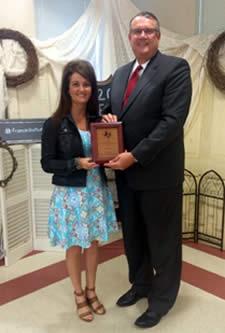 August 10, 2015 - At the state conference for the Texas Extension Association of Family & Consumer Sciences in July, Jheri-Lynn McSwain, Shelby County Extension Agent for Family and Consumer Sciences was awarded three individual state level awards, one team award, and two multi-county awards for programs conducted in 2014.
August 10, 2015 - At the state conference for the Texas Extension Association of Family & Consumer Sciences in July, Jheri-Lynn McSwain, Shelby County Extension Agent for Family and Consumer Sciences was awarded three individual state level awards, one team award, and two multi-county awards for programs conducted in 2014.
Jheri-Lynn was awarded the New Professional of the Year for programming efforts in Shelby County. She conducted over 60 programs with over 5,241 participants during 2014.
She was also presented the Communications through Photography award for her picture of the “Top 3 Biggest Losers of Weight in Shelby County.” This 12-week program had 98 participants which lost over 725 lbs while learning about nutrition and fitness.
Her last individual award was Communications through Marketing for her annual Friend to Friend Breast Cancer awareness program. This program helped fund mammograms for 47 women at risk in Shelby County.
The Curriculum Enrichment Team award was presented to Jheri-Lynn McSwain and Lane Dunn, Shelby County Extension Agent for Agriculture and Natural Resources for their annual Agriculture and Education Safety Day. This youth program was hosted in May with over 900 children attending in 2014 and 1,050 in 2015 to learn about the importance of agriculture and nutrition.
Jheri-Lynn, along with other members of her FCS team, was presented the Early Childhood Child Care Team award for their annual Child Care Conference. The conference is held annually in Palestine to provide CEUs for child care providers. In 2014 the conference hosted 75 participants with Mrs. McSwain as a guest presenter providing a program on “Gardening with Children.”
The Multi-County Programming Team award was presented to Jheri-Lynn, along with other members of her FCS team, for their annual Dinner Tonight program. The program was conducted in Palestine with 60 participants enjoying food prepared by Chef Simon Webster and FCS agents while learning nutritious cooking tips.
In February, The Better Living for Texans program was awarded to Jheri-Lynn as the 2014 Bronze level winner for Regions 4 and 5 by completing over 160% of hours towards programs involving low-income audiences.
August 10, 2015 - As more families grow their own food, there has been an increase in the number of people collecting their own seeds. Home gardeners who save their own seeds know exactly what plants they will be growing next year. Saving seeds also gives people a chance to swap seeds with other gardeners.
The general concept of seed saving is allowing specific annual vegetable plants to grow to full maturity — until the fruit is over ripe — and then harvesting and saving the seeds from the fruit.
Keep in mind with seed saving, you need to only collect seeds from healthy plants. If a plant appears diseased in any way, it will not be a good choice since some diseases are seed born and could cause problems in the future.
Heirloom tomatoes, peppers, beans and pea plants are great for beginning seed savers because they self-pollinate and typically don’t collect genetic traits from nearby plants.
Additionally, by collecting the seeds from plants that performed the best this summer, you can breed your own selection of vegetable plants and save many of the genetic characteristics that make those plants well suited for your particular garden.
For instance, if you grow a tomato plant that is resistant to a certain disease, allow that plant to reach maturity and save seeds from it so that this disease-resistant trait is passed along to future generations.
If you are not familiar with the idea of allowing a vegetable plant to reach maturity, this is when the fruits are allowed to fully ripen on the plant. This will allow the plant to produce viable seed, which can be saved for planting in future years.
For peas and beans, maturity is when the pods have dried and turned brown on the plant, but before they split open and release the seeds. The pods can then be shelled or broken open to remove the seeds.
To save seed from fruited crops (tomato, melons, cucumbers, squash, and pumpkins), begin by selecting clean, disease-free, fully ripe (or over-ripe) fruits as seed sources. Cut the fruit open using a clean knife and scoop or squeeze the seeds into a clean container. Add water to the container and keep the container at room temperature, allowing the mixture to ferment for several days. Stir daily to help separate seed from the pulp.
After several days the mixture should be good and frothy. You will notice many seeds floating to the top of the container: these ‘floaters’ are nonviable, or at best will produce weak seedlings.
Strong, viable seeds will sink to the bottom of the container. Pour off the pulp and floaters, leaving the good seeds in the bottom of the container. Repeat this process several times, adding fresh water each time and allowing the seeds to settle before pouring off the water.
Tomato seed can be difficult to remove from paper or cloth towels, as well as paper plates or non-rigid plastic: you may want to test a few drying surfaces. Many tomato seed savers have good success with coffee filters.
Store the seeds in a cool, dry and dark place until they will be used. I often store my seeds in mason jars with a good air-tight lid and then place these in the refrigerator. If you place the seeds in paper envelopes for each type, many seeds can fit in the jars. The good news is that many vegetable seeds can last three to four years or more with proper storage.
Peppers are also easy to save. Allow the fruits to reach a wrinkled state on the plant. Then cut the fruit open and remove the seeds. They will need to dry before storing for the winter.
Next spring, when you start your seedlings, you’ll have one less trip to make to the garden store thanks to your saved seeds. You’ll also have the peace of mind that comes from knowing that your garden will be full of plants well suited to your area.
Lane Dunn is the County Extension Agent for agriculture and natural resources for Shelby County. His email address is jldunn@ag.tamu.edu.
Educational programs of the Texas AgriLife Extension Service are open to all people without regard to race, color, sex, disability, religion, age, or national origin.
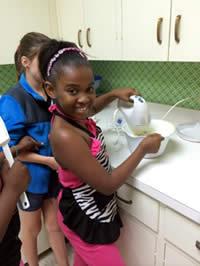 July 27, 2015 - Calling all Shelby County youth and parents. Have you ever wanted to learn something new and different while having fun? Well we have it, from cooking, taking pictures, fashion, robotics, shooting sports, raising and showing livestock and much, much more for youth 3rd through 12th grades.
July 27, 2015 - Calling all Shelby County youth and parents. Have you ever wanted to learn something new and different while having fun? Well we have it, from cooking, taking pictures, fashion, robotics, shooting sports, raising and showing livestock and much, much more for youth 3rd through 12th grades.
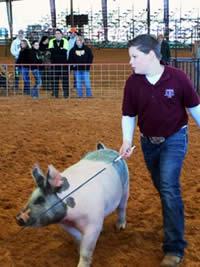 Shelby County 4-H is getting ready to start up their new project year with our annual 4-H Kickoff which is scheduled for Sunday, August 30, 2015 from 2:00 – 4:00 p.m. at the Community House on San Augustine Street, Center. This fun-filled, hands-on event will allow the youth to try their hand at the various projects. Adults will have the opportunity to sign their children up for 4-H during the event.
Shelby County 4-H is getting ready to start up their new project year with our annual 4-H Kickoff which is scheduled for Sunday, August 30, 2015 from 2:00 – 4:00 p.m. at the Community House on San Augustine Street, Center. This fun-filled, hands-on event will allow the youth to try their hand at the various projects. Adults will have the opportunity to sign their children up for 4-H during the event.
4-H is a national organization which helps young people develop life-long knowledge and skills to become engaged citizens. Through 4-H, youth are also taught how to meet the diversities and challenges of today’s society by bringing together youth and adults to design programs that will teach skills for living. 4-H is truly a model of the “learning by doing” teaching concept. It reaches people in their own communities with delivery methods suitable to their needs. 4-H also helps to provide opportunities for families and communities to develop stronger bonds.
So, come see what Shelby County 4-H has to offer your child on August 30th. If you have any questions regarding this event or any others, please do not hesitate to contact the Shelby County Extension Office at 936-598-7744, Lane Dunn, M.S., Ag/NR Agent and Jheri-Lynn McSwain, M.Ed., M.S, FCS Agent.
July 27, 2015 - Whether it’s a first date or an anniversary surprise for your bride, going on dates doesn't always have to mean draining your wallet at fancy restaurants. There are plenty of affordable and entertaining dates you can go on with your beloved. After all, it's really the time you spend with your sweetheart that matters and not how much you're spending on the dates.
But dating for long-term couples comes with its own new his and her matching set of pressures, especially when kids are in the picture. You no longer have the time to make sure you have five minutes together without interruption, let alone set aside an entire evening to dote on each other. So when the stars are finally aligned — you've cleared your calendars, you've found someone not featured on America's Most Wanted to look after the kids — you want the evening to be perfect, which practically begs for a Murphy's Law moment. Don't sweat it! We’ve done the work for you. Texas A&M AgriLife Extension Service and Sabor A Pasion are hosting “Date Night with Dinner Tonight” that you don’t want to miss!
This event will be held Friday, August 7 from 6-8 p.m. at the Nacogdoches County Annex Building in Nacogdoches, Texas located on 203 West Main Street.
The evening will include food demonstrations prepared by Stephen F. Austin’s very own Chef Todd Barrios, Executive Chef Simon Webster of Sabor a Pasion, and Family & Consumer Sciences Extension Agent Mandy Patrick. Food demonstrations will highlight recipes that are easy to prepare and fit into a healthy meal plan with a few surprises from our chefs as well. Samples of the recipes will be available for tasting by the entire audience.
Each participant will receive a flash drive copy of the 52 page Dinner Tonight Cookbook and door prizes will be given throughout the evening. Jessica Theimer, RDN, LD Program Coordinator for Dinner Tonight! will be on hand to demonstrate new and innovative kitchen gadgets that are sure to make a couples dinner more fun.
The cost of the event is $35 per couple in advance or $40 at the door. Tickets can be purchased from 8:00 am- 5:00 pm at the County Extension Office located on 203 West Main Street in the Courthouse Annex Building in Nacogdoches Texas.
For additional information, contact Nacogdoches County Extension Agent Claudann M. Jones at (936) 560-7711- email cmjones@ag.tamu.edu, Holly Black, Anderson County at (903) 723-3735 -email hdblack@ag.tamu.edu, Jheri-Lynn McSwain, Shelby County jlmcswain@ag.tamu.edu, 936-598-7744, Carolyn Tyler, Henderson County Carolyn.Tyler@ag.tamu.edu 903-675-6130, Mandy Patrick Houston County, mkpatrick@ag.tamu.edu 936-544-7502. You can also view recorded food demonstrations on our Dinner Tonight Website at http://healthyliving.tamu.edu with recipes that are easy to download.
 July 24, 2015 - A food handler’s course, accredited by the Texas Department of State Health Services, is being offered by Texas A&M AgriLife Extension Service. Food Safety: It’s In Your Hands will be offered by the Shelby County Extension Office on Wednesday, August 20th, from 3:30 – 5:45 p.m. at the Senior Nutrition Site located at 3580 Loop 500 East, Center, Texas 75935.
July 24, 2015 - A food handler’s course, accredited by the Texas Department of State Health Services, is being offered by Texas A&M AgriLife Extension Service. Food Safety: It’s In Your Hands will be offered by the Shelby County Extension Office on Wednesday, August 20th, from 3:30 – 5:45 p.m. at the Senior Nutrition Site located at 3580 Loop 500 East, Center, Texas 75935.
This two-hour course is highly recommended for all food service employees to promote the service of safe food. The course is a basic overview of food safety practices that are necessary to ensure that safe food is served at your establishment. Practices discussed include good personal hygiene, cross contamination, and time and temperature abuse.
To register for this course, contact Jheri-Lynn McSwain, County Extension Agent at 936-598-7744 or jlmcswain@ag.tamu.edu. Registration can also be done in person the day of the course. The cost is $25 per person (check or money order) and must be paid in full before the course begins. The class is taught in English but Spanish handouts are available if requested in advance. You can also complete your food handler’s card online at www.foodsafetyonline.tamu.edu.
July 24, 2015 - The Shelby County Extension Office hosted another beekeepers meeting on July 16. This meetings subject was summer beehive management.
This insect that we depend upon for a third of our food has a number of natural problems even before human neglect can run its course. In fact, beekeepers spend a good amount of time treating for the problems both in and outside the hive.
Honeybees have their own diseases, insects, mites, and four-legged problems. While is sounds counter-intuitive, beekeepers do indeed use “pesticides” to keep some of these “pests” from harming the honeybee.
The Varroa mite is considered by many to be the most serious malady of honey bees. It now occurs nearly worldwide. This external parasite feeds on the blood of adult bees, larvae and pupae. In addition this blood sucking parasite is responsible for spreading some diseases.
The small hive beetle, North America's newest beekeeping pest, was first discovered in Florida in the spring of 1998. Small hive beetle larvae consume pollen and comb but also will eat larval honey bees. After completing the larval stage, they crawl out of the hive and pupate in the soil. Adult beetles will feed on honey bee eggs.
Adult female wax moths fly at night and deposit masses of eggs on unprotected beeswax combs and in the cracks between hive bodies. After a few days these eggs hatch into caterpillars or larvae. The larvae crawl onto the comb and begin their feeding activity in protected areas, often near the center midrib of the cells.
Mice are a serious pest of stored combs and active honey bee colonies during the fall and winter months. These rodents chew combs and frames to make room for building their nests. Mouse urine on combs and frames and bees are reluctant to use the combs or clean out these nests in the spring.
Also, nosema disease, an adult disease caused by a protozoan, weakens the digestive track of infected bees and may allow pathogens to enter the honey bee's gut where they can cause significant damage.
In some areas, skunks are a serious threat to successful beekeeping, since they hamper the development of strong colonies. Being insectivorous (insect-eating), skunks will raid bee yards nightly, consuming large numbers of bees. To capture bees, skunks scratch at the hive entrance and guard bees that come out to investigate the disturbance. A successful skunk will repeat the process several times and may feed at the hive entrance for an hour or more to rapidly depleting the bee population. Colonies visited by skunks may become defensive since skunks usually return night after night.
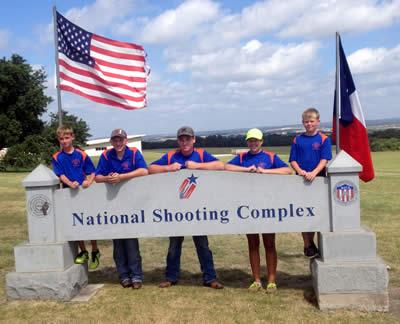
July 21, 2015 - The 2015 Texas State 4H Games were held July 15-18 at the National Shooting Complex in San Antonio. There were over 1,250 shotgun and archery shooters that competed this year.
Jaxon Brittain competed in archery 3d, modified 600, field and wand competitions. Shelby County 4H shooters had five kids participate in the shotgun competition. They were Colton Gutermuth, Lance Holloway, Logan Holloway, Seth Shamblin and Konner Windham.
The shotgun competitions included International Skeet, Modified Trap, American Skeet, American Trap, Sporting Clays and Whiz-bang. It was a great week and it marked the sixth year that Shelby County has been participating in the State Games.
Senior One Ladies: Konner Windham - Whiz-bang (2nd place)
Intermediate Division:
Two man team - Trap (1st place) Logan & Lance Holloway
Two man team - Skeet (2nd place) Logan & Lance Holloway
We would like to say Congratulations on a job well done representing Shelby County.
July 21, 2015 - 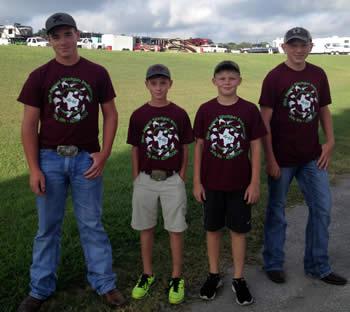 The 15th annual Comal County Shotgun invitational was held at the National Shooting Complex in San Antonio on July 11-12th. This competition is commonly called the state warmup tournament with over 350 participants. Shelby County 4h Shooters had four kids participate; Colton Gutermuth, Lance Holloway, Logan Holloway and Seth Shamblin.
The 15th annual Comal County Shotgun invitational was held at the National Shooting Complex in San Antonio on July 11-12th. This competition is commonly called the state warmup tournament with over 350 participants. Shelby County 4h Shooters had four kids participate; Colton Gutermuth, Lance Holloway, Logan Holloway and Seth Shamblin.
Jr. Division - Seth Shamblin 3rd skeet
We would like to say Congratulations on a job well done representing Shelby County.
July 20, 2015 - Members of the Shelby County 4 H Horse Project traveled to Athens, Texas to compete in the East Region 4 H Horse Show. The horse show consists of districts 4 and 5 just over 40 counties that compete.
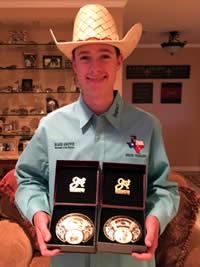 Blake Griffin competed in many events placing 1st in Breakaway Roping, 1st in Calf Roping, 2nd in Team Penning, 3rd in Working Cow Horse, 3rd in Cow Boxing, 6th in Ranch Sorting and 7th in Reining.
Blake Griffin competed in many events placing 1st in Breakaway Roping, 1st in Calf Roping, 2nd in Team Penning, 3rd in Working Cow Horse, 3rd in Cow Boxing, 6th in Ranch Sorting and 7th in Reining.
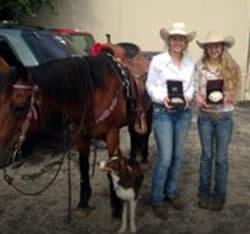 Lauren Vandrovec competed in multiple events placing 1st in Ranch Sorting, 2nd in Team Penning, 7th in Stock Horsemanship and 10th in Poles.
Lauren Vandrovec competed in multiple events placing 1st in Ranch Sorting, 2nd in Team Penning, 7th in Stock Horsemanship and 10th in Poles.
Alli Baldwin placed 2nd in Team Penning, and 7th in Ranch Sorting.
A big thank you goes out to our horse project leaders Mike Baldwin, Rusty Hall and Robert Griffin for their time and dedication to the youth in our 4 H horse project. When you see these 4 H members tell them congratulations for a job well done.
Educational programs of the Texas AgriLife Extension Service are open to all people without regard to race, color, sex, disability, religion, age, or national origin.
Lane Dunn is the County Extension Agent for agriculture and natural resources for Shelby County. His email address is jldunn@ag.tamu.edu.









